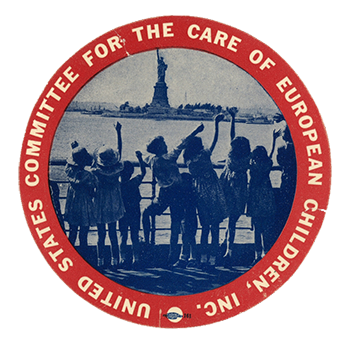
Refugee Children Arrive from France, More to Follow
The United States Committee for the Care of European Children organized one of the largest American efforts to aid refugee children during World War II.
View newspaper articlesIn May 1940, with Nazi Germany threatening to invade Great Britain, some Americans mobilized to evacuate British children to the United States. This effort only lasted for a few months, ending when the SS City of Benares, carrying British refugee children to Canada, was torpedoed by a German submarine and 77 children died. Still, the effort inspired a new organization to rescue child refugees—the United States Committee for the Care of European Children (USCOM).
The United States Committee for the Care of European Children organized one of the largest American efforts to aid refugee children during World War II. With First Lady Eleanor Roosevelt as the organization’s chairwoman, USCOM brought more than 300 children, most of them Jewish, from southern France, Spain, and Portugal to the United States between 1940 and 1945.
Martha Sharp, a relief worker with the Unitarian Service Committee (USC), organized the first USCOM transport. US State Department officials approved visas for twenty-nine children in southern France; they left for the United States in December 1940. Although most of the children were not Jewish, and some were traveling with or reuniting with parents, Martha Sharp’s efforts served as a model for future USCOM transports which would largely consist of Jewish refugee children.
In early 1941, USCOM partnered with the American Friends Service Committee (AFSC), a Quaker aid organization, to continue rescue efforts. AFSC relief workers in southern France interviewed and selected child refugees from children’s homes and French internment camps. Some of the children’s parents had been imprisoned and many were later deported to Auschwitz-Birkenau and murdered in the Holocaust.
Emigrating from Europe was difficult and expensive, and USCOM had to arrange travel for children from France through Spain in order to reach Portugal, because, by 1941, almost all of the available passenger ships to the United States departed from Lisbon. USCOM worked within a network of many cooperating relief agencies: the American Jewish Joint Distribution Committee paid for ship tickets with the assistance of the Hebrew Immigrant Aid Society (HIAS). When children reached the United States, the German Jewish Children’s Aid organization, the US government’s Children’s Bureau, and the National Refugee Service supervised their care. Most of the children were placed with volunteer foster families.
On Saturday, May 31, 1941, 100 children and their adult chaperones boarded a train and began their journey from Marseille to Lisbon. At the train’s first stop, some of the children were able to see their parents, who were interned in the nearby Gurs concentration camp, for the last time. These 100 children departed from Lisbon aboard the SS Mouzinho on June 10, arriving in New York Harbor on June 21. A second group of forty-five children, also on the Mouzinho, arrived in New York on September 2, and a third group of fifty-seven children disembarked in New York from the SS Serpa Pinto on September 24, 1941. Each transport included additional children who were not officially part of the USCOM program, but tagged along to reunite with relatives already in the United States.
After Japan’s bombing of Pearl Harbor on December 7, 1941, led the United States to enter World War II, USCOM transports temporarily ceased. The fourth group of children brought to the United States by USCOM arrived in New York on June 25, 1942, on the Serpa Pinto, departing from Casablanca instead of Lisbon so that the children of Spanish Republicans, who would have been denied transit visas through Spain, could be included. A fifth transport, also from Casablanca, sailed on the SS Nyassa, arriving in Baltimore on July 30, 1942.
In total, some 300 child refugees came to the US on these five USCOM transports and on Martha Sharp’s initial transport. After Nazi Germany invaded southern France in November 1942, USCOM was no longer able to evacuate children from that area, though they later brought some additional children from Spain and Portugal. Among the subsequent USCOM transports were 31 children who had escaped over the French-Spanish border through the Pyrenees and departed from Lisbon on January 8, 1943 arriving in Philadelphia on January 24, 1943. USCOM remained active throughout the war both supporting the children already in the United States and remaining prepared in case any new opportunity arose to rescue more.
Learn More about this Historical Event
- United States Committee for the Care of European Children (Americans and the Holocaust Online Exhibition)
- The Immigration of Refugee Children to the United States (Holocaust Encyclopedia)
- Martha and Waitstill Sharp (Holocaust Encyclopedia)
- American Jewish Joint Distribution Committee and Refugee Aid (Holocaust Encylopedia)
- Quakers (Holocaust Encyclopedia)
- Eleanor Roosevelt (Holocaust Encyclopedia)
Search tips
These dates and keywords are associated with this historical event.